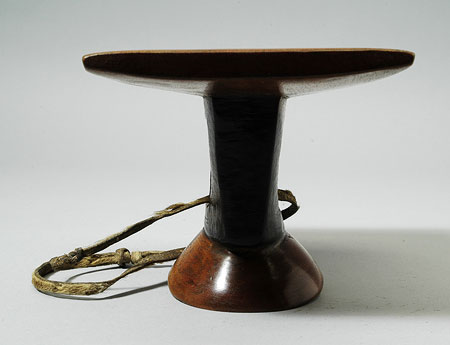Accession Number:
1939.7.03
Country:
Uganda
Cultural Group:
Acholi
Date Made:
By 1939
Materials:
Wood Plant , Animal Hide Skin
Process:
Carved , Stained , Polished , Knotted
Dimensions:
Ht = 138, seat L = 225, W = 163, th = 14 mm; pedestal body Ht = 80, W = 97.5, th = 36.8, fenestration L = 50, W = 35; foot L = 114.8, W = 94; strap L = 328, W 6.8, th = 1.2 mm [RTS 11/4/2005].
Weight:
>1000 g
Other Owners:
Owned originally by Amet, chief of the Amiel; obtained by Armine Charles Almroth Wright in July 1939
Field Collector:
?Armine Charles Almroth Wright
PRM Source:
Armine Charles Almroth Wright
Acquired:
Loaned July 1939
Collected Date:
By 1939
Description:
Stool carved from a single piece of wood and consisting of a rectangular seat with very slightly concavely cut front and back edges and straight sides.
The upper surface is essentially flat, with an extremely slight convex slope across the width, and concave slope along the length.
A pedestal foot extends from the centre of the seat underside; this is rectangular in section with concave sides, and has a rectangular window cut through the centre.
It has been offset from a solid, conical foot with convex sides on a flat, oval base that has bevelled edges along the two long sides.
The natural colour of the wood appears to be a yellowish brown (Pantone 7510C), with the seat and lower foot being stained an orange (Pantone 723C) to reddish brown colour (Pantone 497C), the latter most marked on the flat sides of the seat, while the pedestal section has been either stained or burnt a darker brown (Pantone black 4C).
All surfaces except the underside of the foot have also been highly polished.
A carrying loop has been tied through the centre of the pedestal, cut from 2 narrow strips of animal hide with buff hair on its outer face (Pantone 7401C).
One of the strips is much longer than the other; they are secured at one end with a loop and knot combination.
The stool is complete and intact, and in very good condition, with minor scratch marks on the upper surface of the seat.
Most tool marks have been polished away, except in the fenestrated area where a rough chiselled surface has been left.
It is 138 mm high; the seat is 225 mm long, 163 mm wide and 14 mm thick at the edges; the pedestal body is 80 mm long, 97.5 mm wide and 36.8 mm thick, while the opening through its centre measures 50 by 35 mm; the foot is 114.8 mm long and 94 mm wide, and the carrying strap is 328 mm long as tied, 6.8 mm wide and 1.2 mm thick
.
This stool originally belonged to Amet, chief of the Amiel; it was obtained by Armine Charles Almroth Wright and loaned to the Pitt Rivers Museum in July 1939.
It is said to be made of Balanites aegyptica, or heglig wood. Note that heglig is an Arabic term, and not its Acholi name. This wood is hard, durable, and easy to work (see Hall, J.B. and Walker, H.D. 1991. Balanites aegyptiaca: A Monograph, School of Agriculture and Forest Sciences Publication No. 3, University of Wales, Bangor). This is the type of stool called a 'leg-and-base' stool by M. Trowell & K.P. Wachsmann, which is used by the Acholi, Bari and Madi ( Tribal Crafts of Uganda, 1953, pp 153-154, pl. 34F).
Rachael Sparks 14/9/2005.
This stool originally belonged to Amet, chief of the Amiel; it was obtained by Armine Charles Almroth Wright and loaned to the Pitt Rivers Museum in July 1939.
It is said to be made of Balanites aegyptica, or heglig wood. Note that heglig is an Arabic term, and not its Acholi name. This wood is hard, durable, and easy to work (see Hall, J.B. and Walker, H.D. 1991. Balanites aegyptiaca: A Monograph, School of Agriculture and Forest Sciences Publication No. 3, University of Wales, Bangor). This is the type of stool called a 'leg-and-base' stool by M. Trowell & K.P. Wachsmann, which is used by the Acholi, Bari and Madi ( Tribal Crafts of Uganda, 1953, pp 153-154, pl. 34F).
Rachael Sparks 14/9/2005.
Primary Documentation:
Accession Book Entry
[Donations X, p.
244] -
A.C.A.
WRIGHT
, ESQ., ...
Granville Park, S.E.13.
[Loans II, p.
301] July
A.C.A.
WRIGHT
, ESQ., ...
Granville Park, London, S.E.13.
[p.
301] 1939.7.03 - Stool of Amet, Chief of AMIEL, E.
ACHOLILAND, UGANDA.
Heglig
wood ie Balanites aegyptica.
Card Catalogue Entry - There is no further information on the catalogue card [RTS 30/1/2004].
Pitt Rivers Museum label - 1939.7.03. UGANDA, E. ACHOLI LAND. Stool of Amet, chief of AMIEL. Heglig wood, Balanites aegyptica. Lent by A.C.A. Wright [circular metal edged label, removed from object because of rust and stored in RDF]; AFRICA, Uganda, ACHOLI. Wooden stool belonging to Amet, chief of Amiel in East Acholiland. Heglig wood (balanites aegyptica). Loaned by A.C.A. Wrght. 1939.7.03 [plastic coated label, RTS 9/4/2005].
Card Catalogue Entry - There is no further information on the catalogue card [RTS 30/1/2004].
Pitt Rivers Museum label - 1939.7.03. UGANDA, E. ACHOLI LAND. Stool of Amet, chief of AMIEL. Heglig wood, Balanites aegyptica. Lent by A.C.A. Wright [circular metal edged label, removed from object because of rust and stored in RDF]; AFRICA, Uganda, ACHOLI. Wooden stool belonging to Amet, chief of Amiel in East Acholiland. Heglig wood (balanites aegyptica). Loaned by A.C.A. Wrght. 1939.7.03 [plastic coated label, RTS 9/4/2005].







